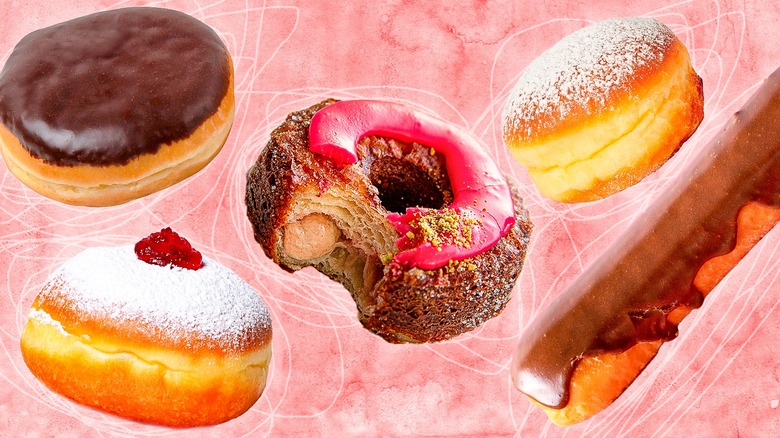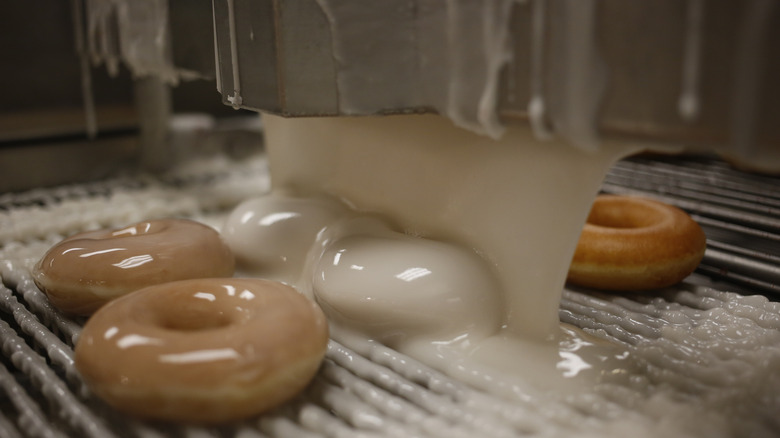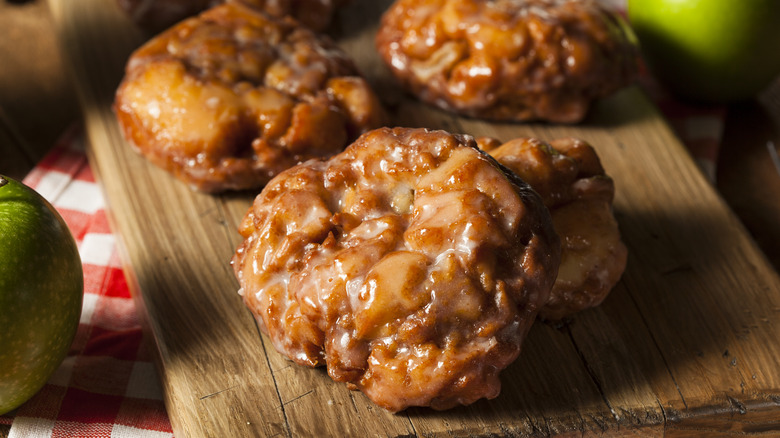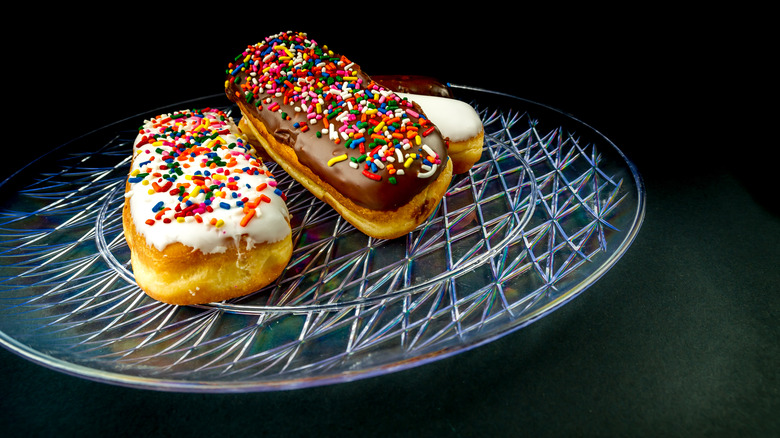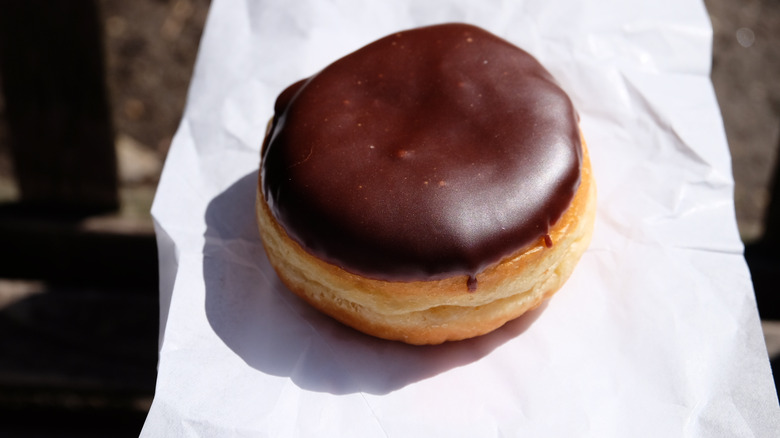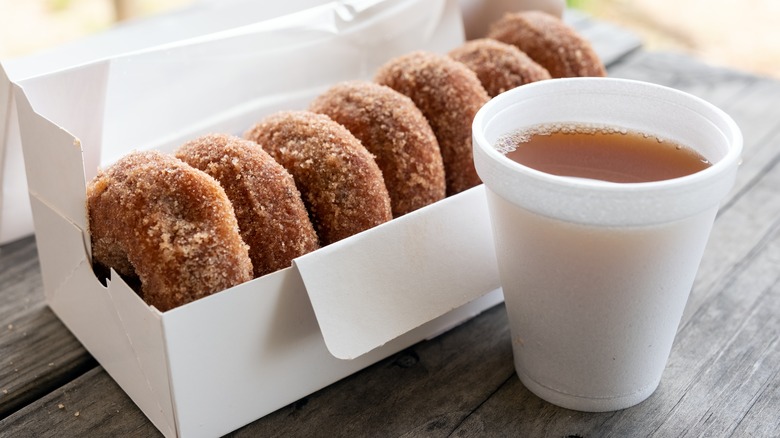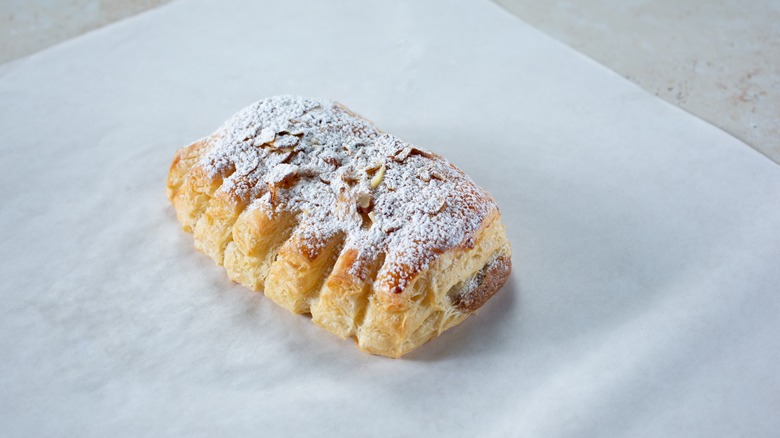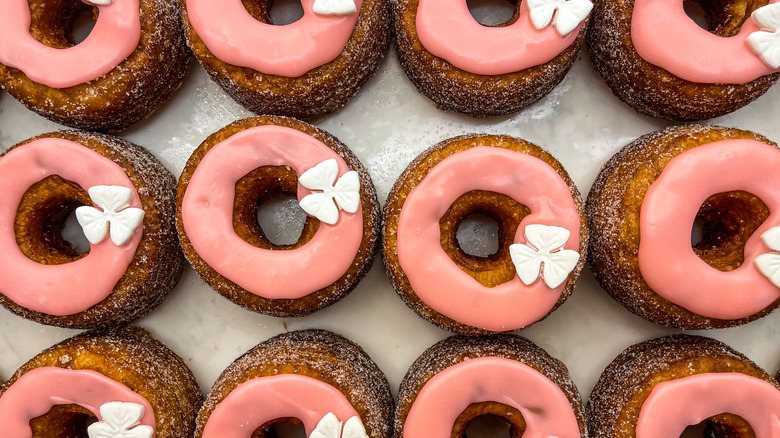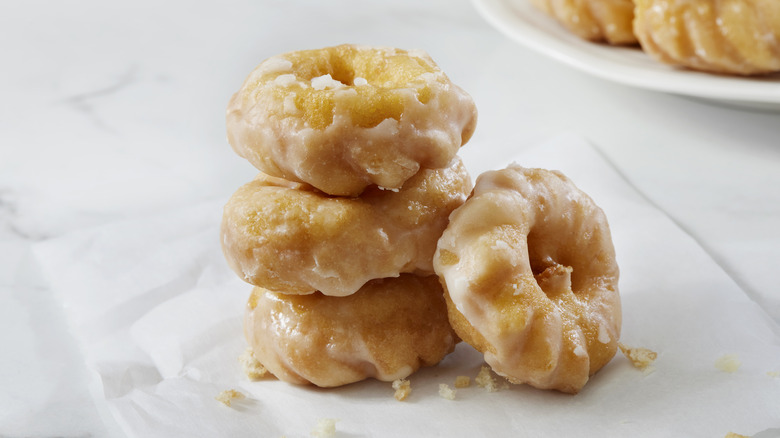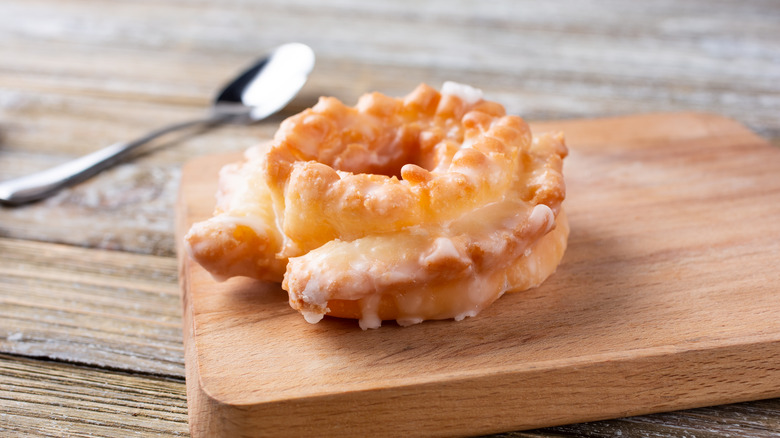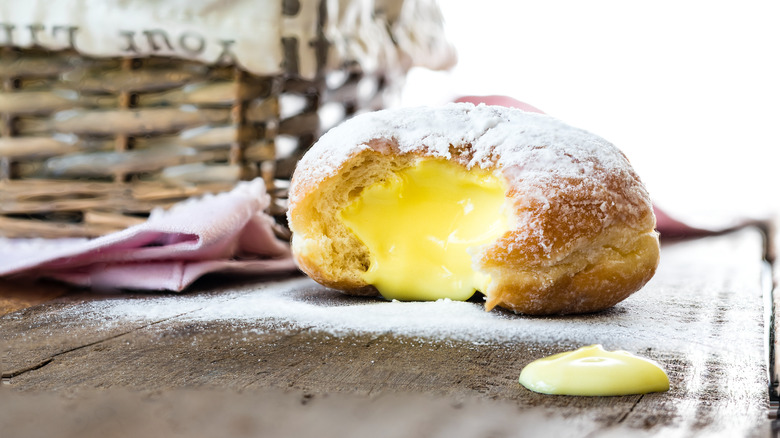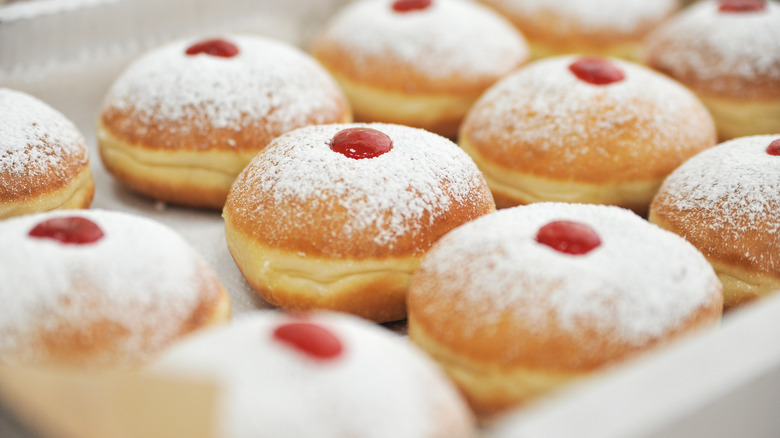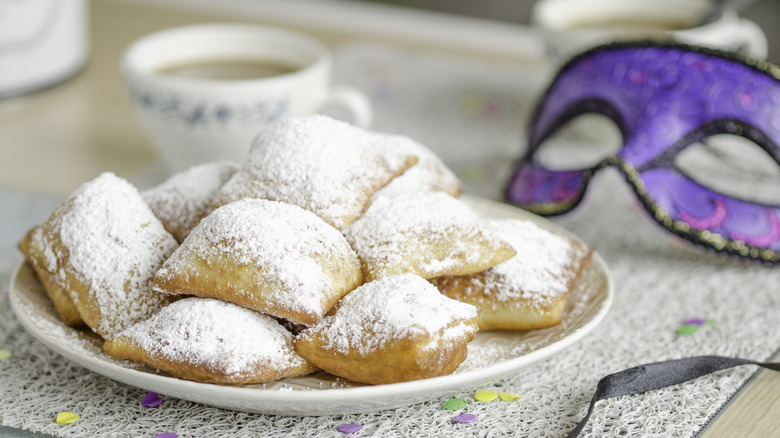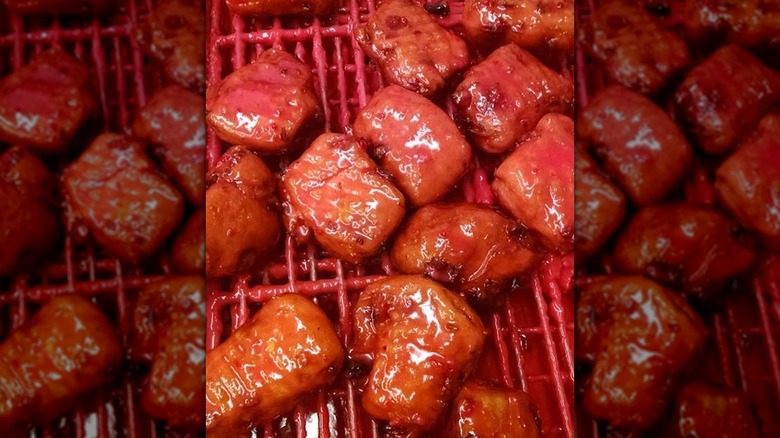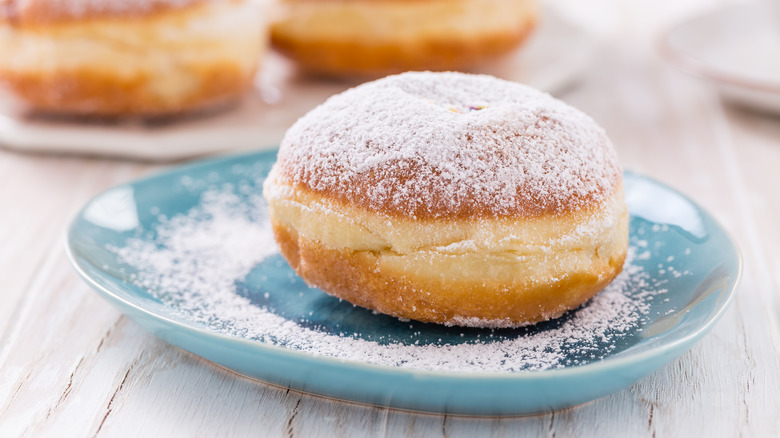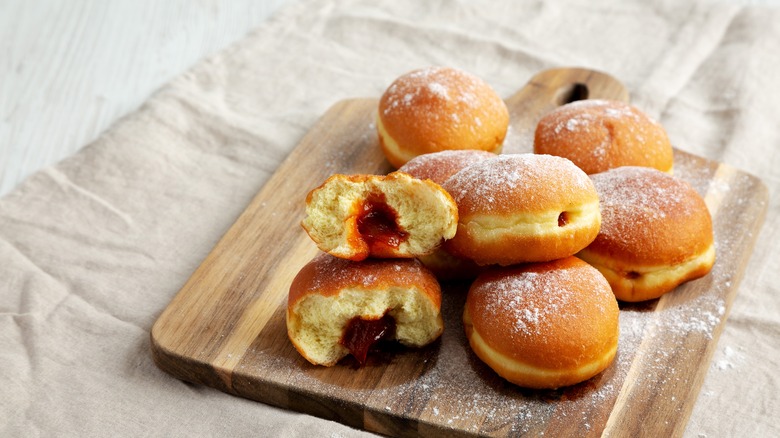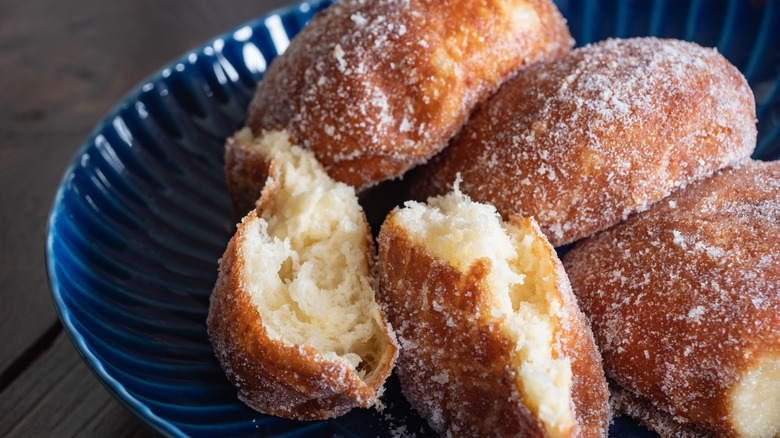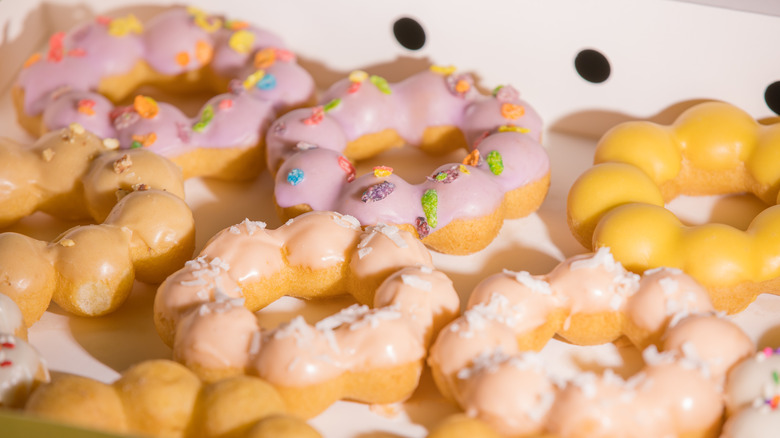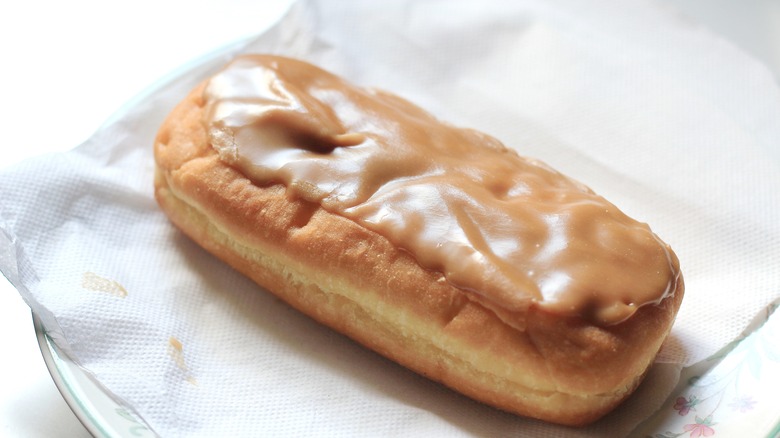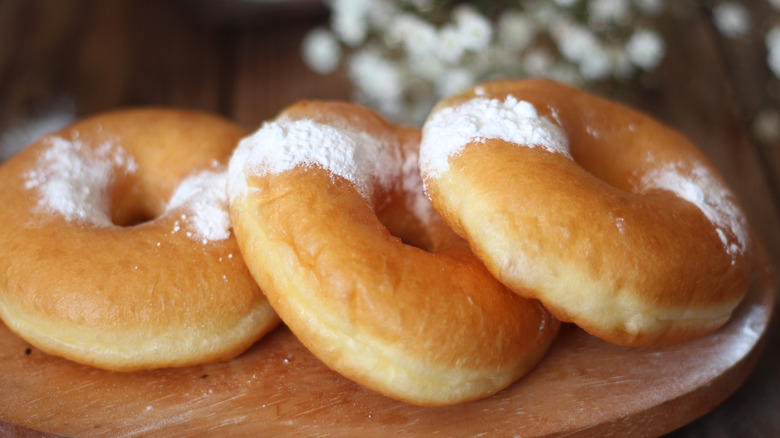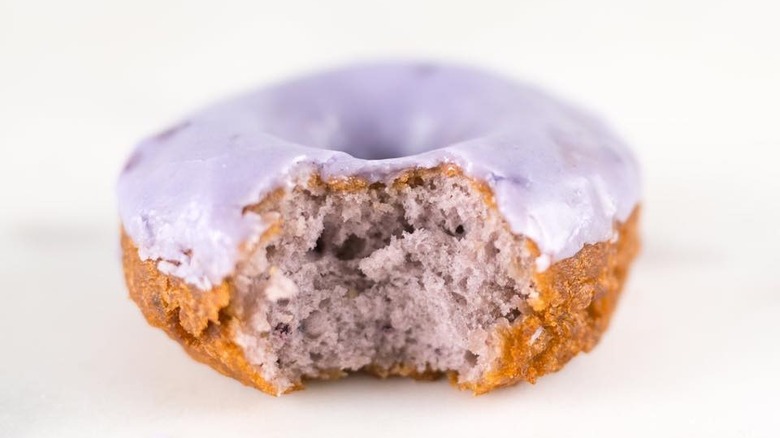20 Popular Types Of Donuts, Explained
There's something universally delightful about starting the day with a freshly baked donut. For many of us, the allure of local bakeries, with a tempting array of extravagant pastries and toppings, is irresistible. The world of donuts is vast and varied, with establishments constantly innovating, crafting extraordinary flavors, and elevating the humble donut into an art form. Yet, amidst this whirlwind of creativity, sometimes all we crave is the comforting simplicity of a classic donut.
Understanding the foundations of this beloved pastry is key. Not every donut shop offers a guidebook to its range; many assume a baseline knowledge of what each type brings to the table. So, whether you're an aficionado seeking to refine your palate or simply aiming to make selecting next weekend's baker's dozen a breeze, it's helpful to familiarize yourself with the basic varieties that are popular, interesting, and delightfully unique in their own tasty ways.
Glazed
Imagine a donut. The iconic image that most likely springs to mind is that of a glazed doughnut, gleaming in sugary perfection. Characterized by its soft, yeasty texture and circular shape, this donut stands out due to its lustrous coat of sweet glaze. The glaze, often a simple mix of sugar, milk, and vanilla, dries to a semi-hard, translucent finish, providing a delightful contrast to the pillowy dough beneath.
If you've ever had the pleasure of visiting a Krispy Kreme outlet when the famed Hot Now sign is lit, you'd be treated to the hypnotic sight of fresh donuts journeying beneath a cascade of glistening glaze. This waterfall ensures that each donut is evenly and generously coated, resulting in that signature sticky, sweet, and utterly irresistible flavor that glazed donut enthusiasts know and love.
Apple fritter
Historically, apple fritters have deep roots in European culinary traditions, often making their anticipated appearance in Christmas markets across countries like Germany and Italy. Yet, there's a notable difference between the continents: In America, apple fritters are renowned for their grandiose size and slightly irregular shape. They are massive in diameter as well as height. In Europe, apple fritters often adopt a more classic donut appearance, sometimes even featuring a central hole.
The term fritter traces its origins in Latin, signifying something fried. Fritters can be both sweet and savory, but apple fritters are unapologetically sweet, combining the comforting allure of spiced apples with soft, fried dough. We think these are basically the perfect fall donuts and go perfectly with a steaming cup of cider.
Long John
The Long John offers a generous portion with its elongated shape, but it also invites a myriad of lavish toppings and fillings, making it a delightful canvas for culinary creativity. While some might mistake Long Johns for éclairs, the most fundamental distinction lies in their makeup: Long Johns are crafted from yeast dough, producing that classic donut texture, whereas éclairs are born from choux pastry, a delicate French concoction.
Spotting a Long John in a pastry display is hardly a challenge. Its oblong shape is distinctive, and it's often adorned with a tempting topping. Though chocolate-covered Long Johns are perhaps the most common – and for many, the epitome of indulgence — the world of toppings is vast, ensuring that this treat offers something for everyone.
Boston cream
The Boston Cream donut is the perfect name for this special pastry, as it is a geographical nod to its birthplace but also deliciously alludes to the luscious custard that nestles within. The story of the Boston Cream donut finds its roots in the historic Parker House Hotel in Boston, Massachusetts. Packed with a velvety vanilla custard, this donut became an instant classic.
While Dunkin' certainly played a pivotal role in catapulting the Boston Cream to incredible fame, it's important to note that the donut world boasts a variety of renditions of this classic. However, the quintessential Boston Cream must possess two key features: the creamy custard heart and a glossy chocolate crown. It's a harmonious blend that offers the best of both sweet realms, making it a perennial favorite for many.
Apple cider
The crisp air, the palette of autumnal colors, and the scent of ripening apples are the unmistakable markers of fall. Among the quintessential activities that herald this season is a trip to the apple orchard. Yet, for many, this excursion is rendered incomplete without the accompanying delight of apple cider donuts.
Tracing their origins back to the early 1900s, apple cider donuts have since become emblematic of fall's festivities. Infused with the subtle tanginess of apple cider and then rolled in a generous coat of sugar, these donuts offer a delightful balance of flavors. Their rise to popularity peaked during the Halloween season, adding a sugary touch to the spookiness of the festivities. Warm, slightly spiced, and with a hint of apple goodness, these donuts encapsulate the essence of fall in every bite.
Bear claw
Among the myriad of donuts hailing from around the world, a contribution from Denmark Americans know as the bear claw is actually a kamime in Denmark. It's distinctive in both taste and appearance.
Layer upon layer of airy dough creates a flaky, buttery foundation for this pastry. Each bite offers a delightful juxtaposition: The rich, buttery texture of the dough melds seamlessly with a subtly sweet topping. The Bear Claw's distinctive look mirrors its name, carved into sections that mimic the segmented digits of a bear's claw.
For the adventurous home baker keen to recreate this Danish delight, there are shortcuts available. Using ready-made puff pastries or even a can of Pillsbury dough can emulate the Bear Claw's characteristic texture. Still, no matter the method, the filling remains a focal point. Many gravitate towards the almond filling, whose nutty richness complements the delicate sweetness of the pastry.
Cronut
In the ever-evolving world of pastries, few creations have caused as much of a sensation as the cronut. This innovative brainchild of Dominique Ansel made its debut on May 10, 2013, at his bakery in New York. Unlike many new culinary inventions that require time to win over the hearts of consumers, cronut's ascent to fame was nothing short of meteoric. Within days, not only did the first batch sell out, but eager patrons also began forming queues outside the bakery, a testament to the pastry's allure.
At a cursory glance, the cronut might seem like your standard donut — circular with a signature hole in the middle. However, a closer inspection (and a bite) reveals a far more intricate texture. Taking inspiration from the buttery, flaky layers of a croissant, Ansel masterfully fused it with the familiar shape and feel of a donut. The result? A multi-layered, airy pastry that offers the best of both worlds.
Cruller
The cruller, regardless of whether it's spelled with a c or a k, represents a unique facet of the vast donut universe. What sets it apart is its textural duality: The outer layer offers an almost temptingly crunchy embrace, only to reveal a soft, rich interior that seems to burst with flavor upon the first bite.
This intriguing pastry doesn't belong to just one culture; it boasts a diverse heritage. The Dutch, German, and Polish culinary traditions have all staked a claim in their origins. This widespread presence speaks volumes about its universal appeal.
While the methods of preparation and flavor nuances might differ across cultures, the foundational concept remains consistent: A deep-fried pastry with a distinctive texture. Its twisted or braided design not only adds to its aesthetic appeal but also contributes to its unique texture.
Old fashioned
The old-fashioned donut is a throwback to simpler times when flavors were straightforward, and every bite was a comforting embrace. It adheres to the familiar appearance, but it has a unique texture and subtle nuances of flavor.
The batter used for these donuts leans towards the lighter spectrum, ensuring a moist outcome that stands out in sweetness compared to its counterparts. Occasionally, there's a hint of a nutty undertone that teases the palate, adding another layer to its profile. But what truly sets the old-fashioned donut apart is its exterior — slightly crispy, offering a delightful contrast to its tender core.
While many modern donuts come bedecked in an array of toppings, the old-fashioned donut takes pride in its minimalism. Traditionally categorized as a cake donut, its only adornment is often a delicate glaze that coats its surface, enhancing its innate sweetness without overshadowing it.
Bavarian cream
At first glance, discerning between a Boston cream and a Bavarian cream donut can pose quite a challenge. Their exterior similarities make them look like twins in the world of pastries. However, like many things, the difference lies beneath the surface, in the heart of the donut — the filling.
On the other hand, the Bavarian cream donut takes a lighter approach to its filling. Unlike the dense custard of its Boston counterpart, Bavarian cream is more akin to a mousse, owed to the whipped cream and gelatin blend. This results in a fluffier, airy texture that's delightfully creamy. Aesthetically, Bavarian cream donuts are often sprinkled with a light dusting of powdered sugar, offering a subtle sweetness that complements its delicate filling. Thankfully, bakeries tend to label donuts clearly, so you won't need to dig into the donut to determine its actual flavor.
Jelly
The beloved jelly donut, or sufganiyot as it is called in Hebrew, is more than just a sweet treat; it carries with it a deep historical and religious significance. Associated closely with Hanukkah, this fried confection serves as a delicious tribute to a miraculous event in Jewish history.
The story behind Hanukkah revolves around the miracle of oil. A small quantity of oil, only expected to last for a single day, miraculously burned for eight days in the Holy Temple of Jerusalem. This extraordinary event is central to the Hanukkah celebration, and the act of frying the sufganiyot in oil becomes a symbolic gesture, honoring that ancient miracle.
Dating back to 1485, the history of the jelly-filled donut is long and storied. Though it has undergone various evolutions and adaptations over the centuries, its association with the Festival of Lights remains steadfast. The traditional filling of choice is often red berry jelly, though modern variations can also include custards, chocolates, and other sweet fillings.
Beignet
Beignets, often associated with the vibrant streets of New Orleans, are more than just pastries; they are cultural icons. These deep-fried square treats are deceptively simple yet irresistibly delightful. Made from dough that's expertly fried until golden brown, beignets are then generously dusted with powdered sugar, resulting in a melt-in-your-mouth experience. Walking through the French Quarter of New Orleans, the aroma of freshly fried beignets is almost omnipresent, guiding visitors to famous spots like Café du Monde. It's not just a treat; for many, savoring a beignet is a rite of passage when visiting the Crescent City.
Beyond the bayous of Louisiana, the magic of beignets has found its way to the enchanting realms of Disneyland and Walt Disney World. Here, the traditional beignet undergoes a delightful transformation, taking on the shape of the iconic Mickey Mouse. These Mickey-shaped beignets are more than just a whimsical play on the original.
Thing-A-Ling
Across the diverse tapestry of the United States bakery scene, the cherry donut is a beloved staple. But in Batesville, Indiana, the game changes every February with the arrival of a special cherry donut: the Thing-A-Ling.
The Thing-A-Ling is not just any cherry donut; it's a delightful fusion. Imagine a cherry donut meeting a fritter and then being crowned with a brilliantly pink glaze. This is precisely what Clem Schmidt envisioned when he introduced this treat, and it has since become an iconic pastry, flying off the shelves of Schmidt's Bakery in staggering numbers annually.
But there's more to the Thing-A-Ling than just its delightful taste and texture. Its availability is a blink-and-you-miss-it affair, exclusively tied to Presidents Day weekend in February. This limited availability is a playful nod to the legendary tale of George Washington and the cherry tree.
Fasnachts
In the broad spectrum of pastries and donuts worldwide, the German pastries, called Fasnachts, stand out with their distinctive shape and taste, since these can be both square and round. A subtle sweetness characterizes the Fasnacht, a departure from the overt sugary profiles of many contemporary donuts. This nuanced flavor can be traced back to its traditional ingredients: A mix of yeast and mashed potatoes, lending it a unique texture and taste.
But the Fasnacht is more than just its form and flavor; it's steeped in history. Its origins can be traced as far back as the 13th century, making it one of the older pastry traditions still alive and relished today. Rooted in pre-Lenten festivities, Fasnachts are traditionally prepared and consumed on Fat Tuesday, the day before the Lenten season commences. This custom is a nod to the idea of indulgence before the period of fasting and reflection.
Paczki
Amidst the myriad of pastries and donuts that make their appearance in the run-up to Lent, the Polish paczki shines as a beloved and flavorful tradition. Recognized by many for its rich and indulgent nature, this treat is more than just a donut; it's a testament to Poland's rich culinary heritage.
At the heart of the paczki is its luxurious brioche-style dough. Soft, airy, and with a buttery richness, the dough serves as the perfect canvas for its fillings. Unlike many traditional donuts that might feature a singular filling, paczkis are often brimming with a variety of preserves. Once stuffed with their flavorful fillings, the paczkis are then deep-fried to golden perfection, resulting in a crispy exterior that contrasts wonderfully with the soft and jam-filled interior. To complete the masterpiece, they are often dusted with granulated sugar or draped in a shimmering glaze, adding another layer of sweetness and texture.
Malasada
A soft, fluffy donut, the malasada stands out with its golden-brown exterior, fried to perfection and generously coated in sugar. But beyond its delightful taste and texture, the malasada boasts an intriguing history that spans continents and centuries.
While malasadas are now synonymous with Hawaiian culture and cuisine, their origins date back further than that when, in 1427, the Portuguese settled on Sao Miguel, where the donut was popular. Fast forward to 1878, when Portuguese plantation workers made their way to Hawaii, bringing with them their customs, traditions, and, importantly, their delicious malasadas. As with many dishes that migrate, the malasada underwent a bit of a transformation in Hawaii. Still enjoyed simply, the islands' rich bounty of flavors, like coconut, also became popular fillings and tasty accompaniments to the traditional malasada.
Mochi donut
In the dynamic world of donuts, where traditional tastes merge with modern twists, the pon de ring stands out. Often referred to as the mochi donut due to its characteristic chewy texture reminiscent of mochi, this treat is a captivating blend of cultures and flavors.
Visually, the pon de ring is distinct. Unlike the continuous curve of a traditional donut, it looks like a ring of small, interconnected balls. The texture is its standout feature. With each bite, you're treated to a delightful chewiness akin to the much-loved Japanese mochi, followed by the contrasting crunch of its outer glaze or dusting.
Although the pon de ring has become synonymous with Mister Donut, one of Japan's largest donut chains, its roots appear to extend beyond Japan's shores. The exact origin is somewhat unclear, but it seems to have both Hawaiian and Brazillian influences.
Maple bar
Among the world of elongated donuts, the maple bar has carved a delectable niche for itself. Essentially, this treat is a variant of the traditional Long John, but it's the luscious maple glaze that sets it apart and gives it its moniker.
Hailing from Portland, a city known for its unique culinary creations, the maple bar rose to fame, particularly due to the innovative efforts of Voodoo Doughnut. While the maple bar can be found in bakeries across the United States but is certainly more popular in some places than others, Voodoo Doughnut, with its quirky approach and array of exciting offerings, helped cement its iconic status, making it almost synonymous with the city's vibrant food scene. This tasty creation is essentially an oblong donut with a maple glaze over the top.
Spudnut
The spudnut is a commercialized take on the traditional German Fasnacht. Its story traces back to Bob Pelton, a former baker in the US Navy during the 1930s. With a catchy moniker, the spudnut, he opened his very first shop in Salt Lake City. While spudnuts owe their inspiration to the German potato donut, they stand out with their distinct circular shape and signature glaze, setting them apart from the sugar-dusted fasnachts.
As the demand grew, Pelton continuously refined the recipe, but the journey wasn't always smooth. Over time, after numerous company sales, the original spudnut chain collapsed. Yet, the love for these potato donuts remained undeterred. A handful of individual stores persevered, sometimes under varied names but largely continuing the tradition of selling these delectable potato donuts.
Blueberry
In 2012, as the New York Giants geared up for a Super Bowl triumph, their taste buds were tingling for a very specific treat. They placed a special order for dozens of blueberry donuts from a quaint bakery located in Canfield, Ohio: the White House Fruit Farm.
This cake donut comes glazed, iced, and plain, and while the exact reason behind its immense popularity is somewhat elusive, the visually captivating light purple icing that gracefully drapes over the blueberry donut certainly helps add to the appeal. And while blueberry donuts are a popular pastry nationwide, there are certainly some bakeries that really knock it out of the park, like White House Fruit Farm. However, most often, when you find a blueberry donut in a bakery, it is a donut with a glaze rather than frosting, like the iconic offering at this farm.
